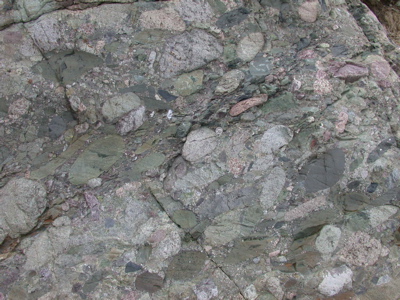 Puddingstone is a conglomerate rock that consists of distinctly rounded pebbles, or clasts, whose colors contrast sharply with the color of the finer-grained, often sandy, matrix or cement surrounding them. The space between the clasts is generally filled with smaller particles and/or a chemical cement that binds the rock together. The term "puddingstone" emerged becasue of the rock's resemblance to an old fashioned fruit-filled pudding
Puddingstone is a conglomerate rock that consists of distinctly rounded pebbles, or clasts, whose colors contrast sharply with the color of the finer-grained, often sandy, matrix or cement surrounding them. The space between the clasts is generally filled with smaller particles and/or a chemical cement that binds the rock together. The term "puddingstone" emerged becasue of the rock's resemblance to an old fashioned fruit-filled pudding
"Conglomerate can have a variety of compositions. As a clastic sedimentary rock it can contain clasts of any rock material or weathering product that is washed downstream or down current. The rounded clasts of conglomerate can be mineral particles such as quartz or they can be sedimentary, metamorphic or igneous rock fragments. The matrix that binds the large clasts together can be a mixture of sand, mud and chemical cement".1
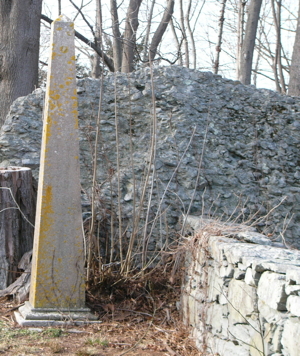 Swansea is part of the Rhode Island Formation which consists of sandstone, graywacke, shale and conglomerate along with minor beds of meta-anthracite. It is the thickest and most extensive formation in the Narragansett basin. It was part of the Upper and Middle Pennsylvanian age from the Paleozoic era.3
Swansea is part of the Rhode Island Formation which consists of sandstone, graywacke, shale and conglomerate along with minor beds of meta-anthracite. It is the thickest and most extensive formation in the Narragansett basin. It was part of the Upper and Middle Pennsylvanian age from the Paleozoic era.3
Swansea is home to Abram's Rock, located in the Village Park located off Main Street. Abram's is a rather large version of the puddingstone rock familiar to cachers in the Southeastern MA area. The rock looms in the distance as you head down the trail, a rather ominous point in the quiet woods. If you are brave enough to climb to the top from the west end, you will find some interesting views of the woods as well as a large fissure. A 'fissure' is "a fracture is any local separation or discontinuity plane in a geologic formation, such as a joint or a fault that divides the rock into two or more pieces. A fracture will sometimes form a deep fissure or crevice in the rock." 4
In the Boston area, conglomerate rocks are also knows as Roxbury Puddingstone. The Roxbury Puddingstone became the state rock of Massachusetts in 1983.
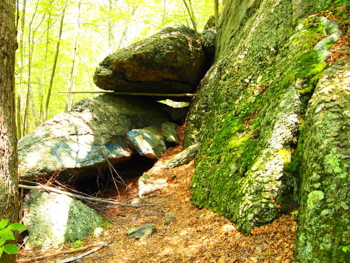 To log this cache you must answer 3 questions PRIOR TO CLAIMING THE FIND. The 3rd question requires you to climb to the top of the rock. If you are physically unable to complete that task, please contact us and we will give you permission to log by only answering the first 2 questions.
To log this cache you must answer 3 questions PRIOR TO CLAIMING THE FIND. The 3rd question requires you to climb to the top of the rock. If you are physically unable to complete that task, please contact us and we will give you permission to log by only answering the first 2 questions.
Question #1: Go to : 41° 45.140, 071° 11.225. From here, you may notice two larger puddingstone formations just below the larger formation. This is the area of "Abram's Bedroom" as mentioned in the folklore below. A sizeable crack runs between the two, almost separating them into different rocks. What do you think caused this large fissure in the rock?
Question #2: Go to : 41° 45.135, 071° 11.191. This is the sheer face of Abram's Rock. (Side note: Cliffside #6 (GCH6JY) is hidden somewhere on the face.) What is the estimated height from ground level to the top of the puddingstone formation?
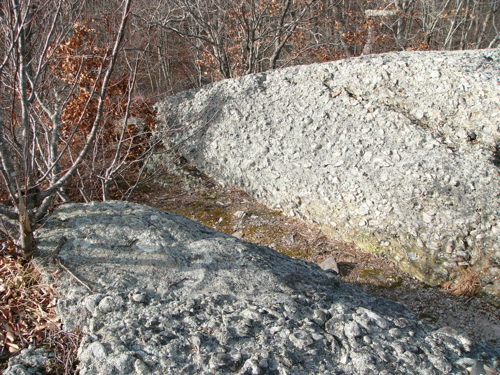 Question #3: Go to : 41° 45.149, 071° 11.205 at the very top of the rock (from where Abram made his there leaps). Please be careful and note the terrain rating as the climb up can be a little treacherous. Autumn views from this point are beautiful. Near the coordinates is a fissure in the rock. What is the estimated width of the fissure at the widest point.
Question #3: Go to : 41° 45.149, 071° 11.205 at the very top of the rock (from where Abram made his there leaps). Please be careful and note the terrain rating as the climb up can be a little treacherous. Autumn views from this point are beautiful. Near the coordinates is a fissure in the rock. What is the estimated width of the fissure at the widest point.
Optional : photo of your cache group on top of Abram's Rock.
You can log the find before sending the answer, but just be sure to email them to the owner. Thank you!
Al little more information about the area provided by REddyCase:
"The rock is between 286 - 325 million years old. During the last glaciation, about 15,000 years ago, the glacier over-rode Abram's Rock and formed it into the classic "ramp and pluck" structure seen today. The glacier was about 1/2 mile high, and, as it moved from the north to the south, it rode over the north side, making it "smooth" and making that side more "gentle" in slope. As the glacier moved over the rock, water froze in the cracks, and, as the glacier continued in a southerly direction, it "plucked" chunks of rock from the southern slope of the rock. Wildcat is an even more classic example of this "ramp and pluck" formation, with the north slope being quite gentle and "smoothened" and the south, quite "plucked."
"Some of the fissures formed from the above, and others formed when the glacier plucked, pulled, and dropped "chunks." Surely the "chunks" that form the "living room" were plucked and dropped into their current positions, and resulted in further fissures."
In addition to the fascinating geology of these rock formations, this one has some interesting local folklore associated with it that we would like to share. The following passage is taken form “The Swansea Stagecoach – A Local History” published by The Swansea Historical Society in 1976:
'Monsters from the Past' by Marjorie E. Walkden
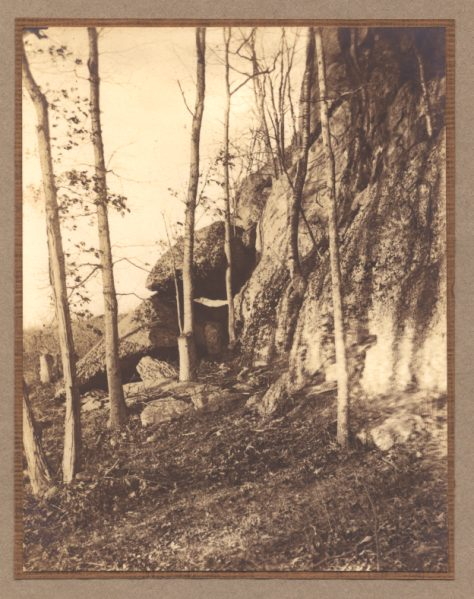 A large boulder north of Swansea Village is known as Abram's Rock. The tall oak trees at its base whisper of the Indians who once trod the ground beneath them or rested in their shade. King Philip might have rested here when hard pressed by his enemies. Farther than the eye can reach were the lands of Massasoit.
A large boulder north of Swansea Village is known as Abram's Rock. The tall oak trees at its base whisper of the Indians who once trod the ground beneath them or rested in their shade. King Philip might have rested here when hard pressed by his enemies. Farther than the eye can reach were the lands of Massasoit.
Swansea has many huge rocks that are named for their weird shape, location, or legends told about them. One has only to know the story and then visit them to realize their importance in the history of the town. "There is hardly a rock, hardly a stone but which is breathing forth history," wrote Orrin Gardner.
The most familiar legend handed on to us about Abram's Rock is that he was a poor Indian who had deserted his tribe, coming to this settlement where he made his living in peace. But King Philip of the Wampanoags decided to take Abram back, fearing his friendship for the white men. Abram found this towering rock as a hiding place. On the west side is a room formed by boulders. It is still called "Abram's Bedroom"-- after 300 years. He is said to have lived there for several months until tracked down and captured. He was given a chance for his life. The sentence was death or three leaps from the top of the rock to the ground below. Abram took the chance and tradition says that his first and second leaps from the towering rock were safely made but the third jump killed him.
...
Some of these great rocks of Swansea are boulders deposited by glaciers thousands of years ago. When the ice melted it left these huge chunks of stone poised on hilltops or deep in what are now woods. Others are broken ledge formations of "pudding-stone"--mixtures of stones and fragments pressed into tremendous masses as if made with cement. They come to us from early ages, often to play a spectacular or merely curious part in our local history. Thereafter, generations of young people find a special interest in the odd stories that haunt these natural "wonders" of Creation. Swansea provides good specimens of quartz, flint, shale, feldspar, granite and conglomerates. These are mixtures fused together.
An added bonus that we just found out about...a trail map! The Trail Elves at BikeWorks in Swansea have created a trail map of the area that we have scanned and included here for you to print. Please click here to view/download the map.
References:
1 - Geology.com - News and Information About geology
- http://geology.com/rocks/conglomerate.shtml
2 - Geology of Boston
- http://www.bostongeology.com/boston/geology/geology.htm
3 - US Geological Society
- http://tin.er.usgs.gov/geology/state/sgmc-unit.php?unit=MAPAr;0
4 - Wikipedi
- http://en.wikipedia.org/wiki/Fracture_(geology)